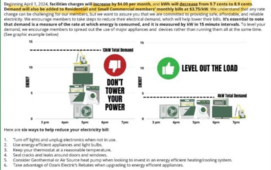OzSolar
Whatever you did, that's what you planned.
I assume this new demand rate is across the board, not exclusively a special treat for solar customers?
Now that I'm taking a closer look at the announcement it's full of issues, at least in my way of thinking.
Their list of "ways to reduce your electricity bill" hasn't been updated since the 90's.
They want to stick you (all of us eventually) for $3.75/kW but are offering suggestions like turn off your lights, unplug appliances and ADD a heat pump.
In other words two things that will do nothing for your demand then one thing that will just blow it up when the strips kick on.
They've got a nice graphic but it's missing both a heat pump and an EV charger.

Now that I'm taking a closer look at the announcement it's full of issues, at least in my way of thinking.
Their list of "ways to reduce your electricity bill" hasn't been updated since the 90's.
They want to stick you (all of us eventually) for $3.75/kW but are offering suggestions like turn off your lights, unplug appliances and ADD a heat pump.
In other words two things that will do nothing for your demand then one thing that will just blow it up when the strips kick on.
They've got a nice graphic but it's missing both a heat pump and an EV charger.



